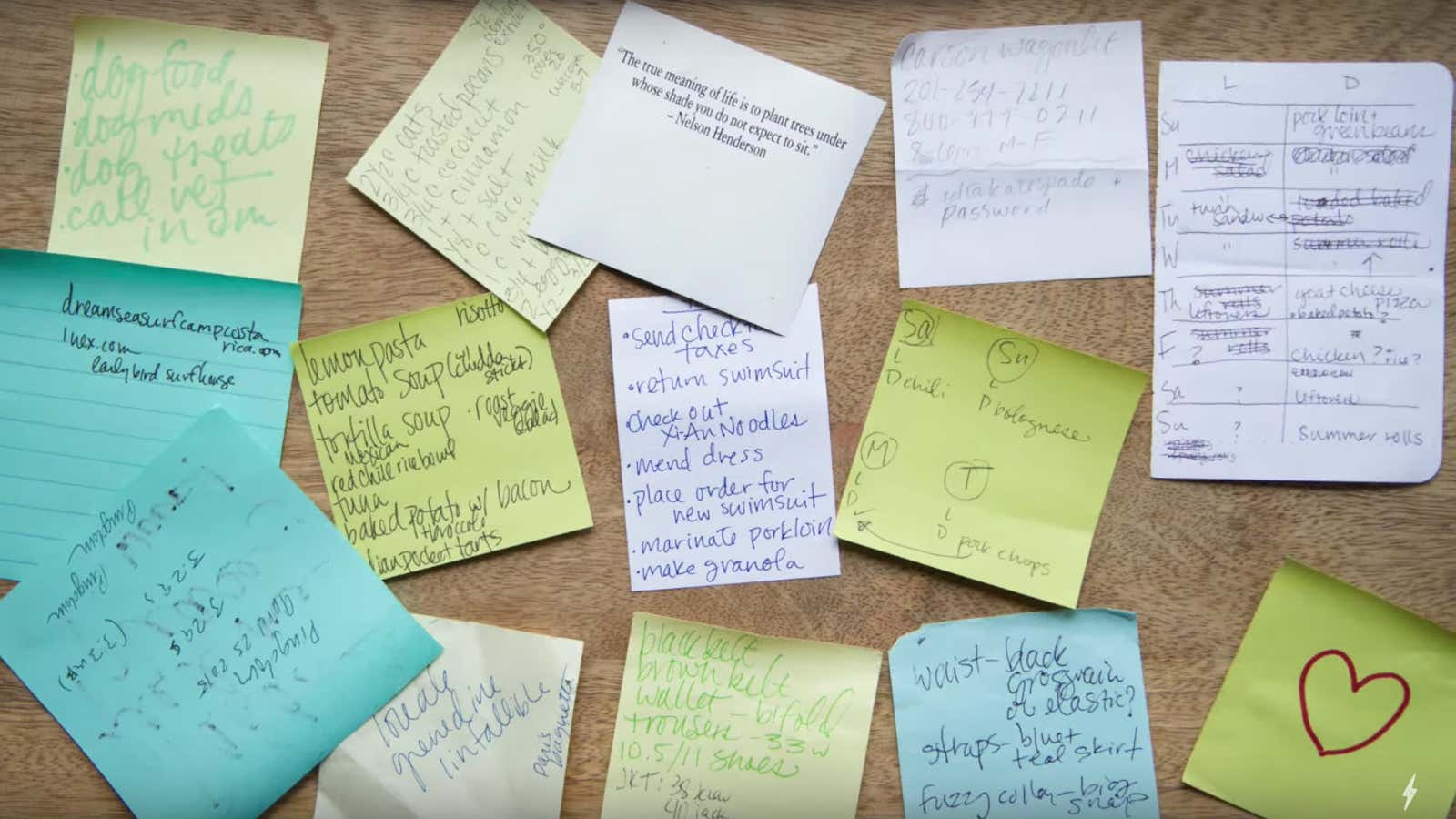A well-crafted to-do list acts as a guiding light for your day. It helps you overcome feelings of being overwhelmed, and reduces anxiety around whether you’re being productive throughout the day. Before I dive in to explain how I craft my to-do list each day, I’d like to point out that to-do lists come in all shapes and sizes—it’s all about what works for you as an individual. This method is what works for me personally; it’s up to you to decide what to implement into your own planning system. I encourage you to try these techniques, but if you find that only some apply to your life, then by all means take what works for you and leave the rest.
1. Have a “master” list
Previously, my “master” list was what I referred to as my “brain dump.” It was a list of non-urgent tasks that were not immediately time-sensitive. I used to house my entire “brain dump” in its own notebook, pictured below.

Once I tackled a task, I would put an “X” through the bullet and make a little note (in parenthesis) to remind myself when I accomplished it, or where the results can be found. I use the notebook threading technique described by Kim at Tiny Ray of Sunshine.
Every time I thought of something that needed to be done, it got added to this master list. When I sat down in the evening to craft my to-do list for the next day, I referenced my brain dump to see what had become a time-sensitive task.
I would also pull tasks from this list if I had a particularly light load the next day and had time to tackle non-pressing items—ones that would be nice to get done and out of the way.
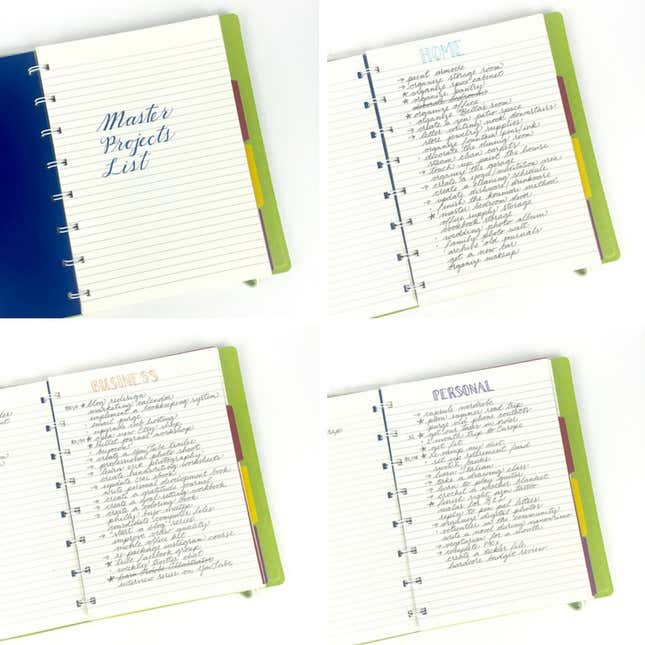
After reading David Allen’s Getting Things Done, some of my methods in this system have evolved. I still have a master list (or, rather, several master lists), but it is more project-focused than task-focused. You can read the full breakdown of how I’m implementing this below.
2. Have a “top three”
Once I have carefully crafted my to-do list for the following day, I look it over and decide which tasks will be my “top three” for the day. Some experts call this a HIT (that’s high-impact tasks) list.
To determine my top three tasks for the day, I ask myself the following questions:
- What task(s) will have the most impact on my day?
- What task(s) needs to get done today?
- If I get nothing else done today, what task(s) will make me feel the most accomplished?
Once I’ve figured out which tasks are the most important, I number them 1, 2, and 3. It’s important to note that I do not necessarily tackle them in that order. I may start with number three because it’s quick and easy. This gets the momentum going in my day and energizes me to tackle the bigger/longer tasks on my list.

Why does this work? Think of your energy level like the gas tank in your car. You fill up first thing in the morning, and start driving all around town running errand after errand. Sooner or later, you will run out of gas and not be able to go anywhere else until you refill (go to bed and get some rest).
You want to hit the important destinations first so that you can make the most of your trip before your gas tank runs dry, right? It’s the same with your energy levels.
Getting those important and time-sensitive tasks out of the way first—while you have a full tank of energy—will free you up to do the smaller, easier tasks later when your energy starts to run low. (Mid-afternoon slump anyone?)
3. Break it down and be specific
To-do’s should be actionable, specific. Tasks such as “work on research paper”—while actionable—are much too vague. Instead, write specific and manageable tasks that you can do in one sitting like “write first paragraph of research paper.”
Breaking larger projects down into more manageable snippets will help you to get more done. Even if each task individually seems tiny and insignificant, when added up over the course of a week or month, they compound in effect.
4. Be intentional with unfinished tasks
I’m willing to bet that your to-do list has a few tasks on it that you’ve been meaning to get to for days, weeks, maybe even years—but just haven’t gotten around to yet. Instead of stressing over these unfinished tasks, try to figure out why they haven’t gotten done.
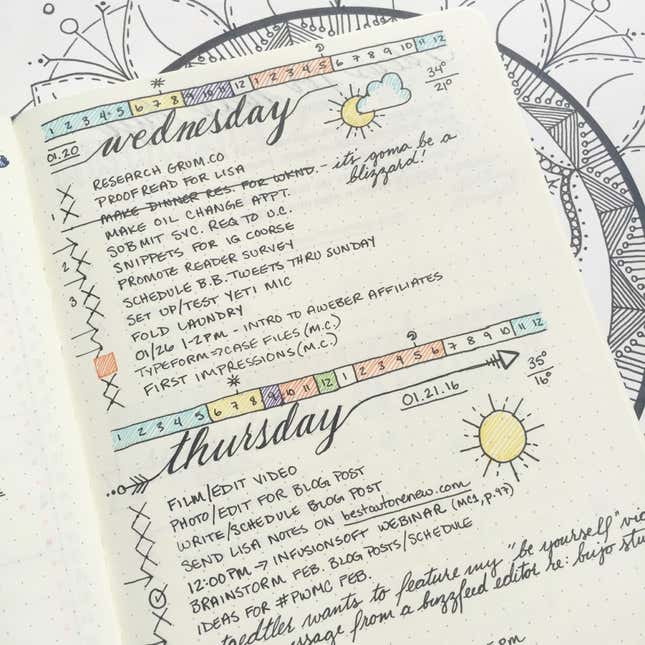
Is it because the task is too broad/daunting? Try breaking it down into more manageable sub-tasks, and tackle just those little bits each day.
Is it because the task is just not important to you? Take a minute to analyze whether that task still holds value. If it doesn’t, there’s nothing wrong with crossing that bad boy out and relieving the stress of it staring you in the face every single day.
Is it because you just don’t want to do it? Some tasks are just a drag. Period. They may be important, but you keep putting them off because you simply don’t feel like it. If this is the case, consider making that task one of your “top three” for the next day. Just get it over with and save yourself the grief.
5. Plan to plan
Scheduling time to plan out your to-do list is the single most important thing you can do to increase your productivity.
Every night before bed, I sit down with my bullet journal and plan out my to-do list for the following day. I analyze what I accomplished that day, move tasks forward, and add in tasks from my master list as needed.
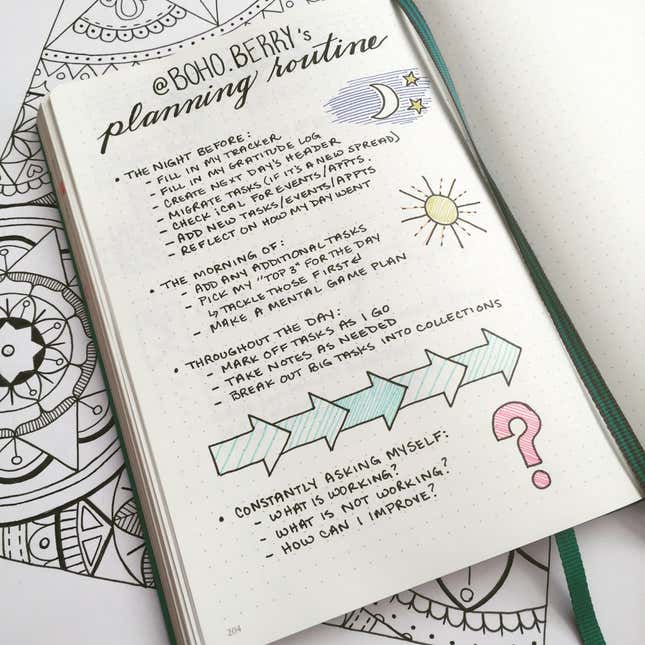
This is akin to setting out your outfit the night before a big morning meeting. You are setting yourself up for success.
Waking up each morning and already having a clear vision of what you need to accomplish that day is invaluable. It initiates a forward momentum in your day. Rather than scrambling in the morning to figure out what you need to do, you can hit the ground running on your most important tasks right away.
6. Consider an “if/then” list
This is something I’m experimenting with in my bullet journal at the moment. Remember how I was talking about energy levels earlier? Well, I’ve come to realize that energy ebbs and flows for me throughout the week.
Some days, I inexplicably find myself with an overabundance of energy and get everything on my to-do list accomplished before noon, leaving me with the afternoon free to work ahead.
Other days, I find myself drained from the moment I wake up. After slugging through my “top three,” I end up procrastinating the rest of the day away.
Here’s a peek at my “if/then” lists:
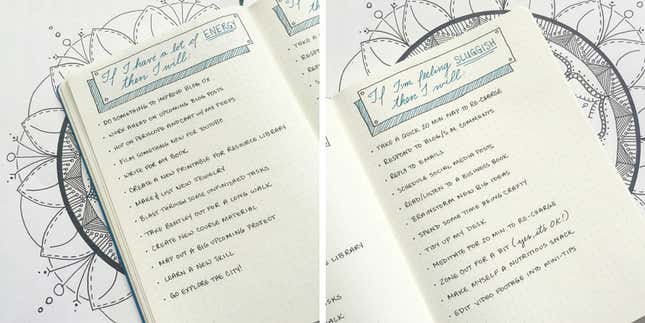
I’ve taken some of my repetitive daily, weekly, and monthly tasks and categorized them into two lists. The first is my “If I have lots of energy then I will…” list, and the second is my “If I’m feeling sluggish then I will…” list.
The concept here is that no matter how I am feeling each day, I can grab an item from the appropriate list and tackle it that day. This way, I’m being productive and can feel good about my day, no matter what.
It is my sincerest hope that you’ve found some helpful advice here for when you tackle your daily to-do list. As I said before, I hope you’ll experiment with these techniques and determine what could be applied to your own to-do list each day in order to make it more efficient.
This post originally appeared at BulletJournal.com.
